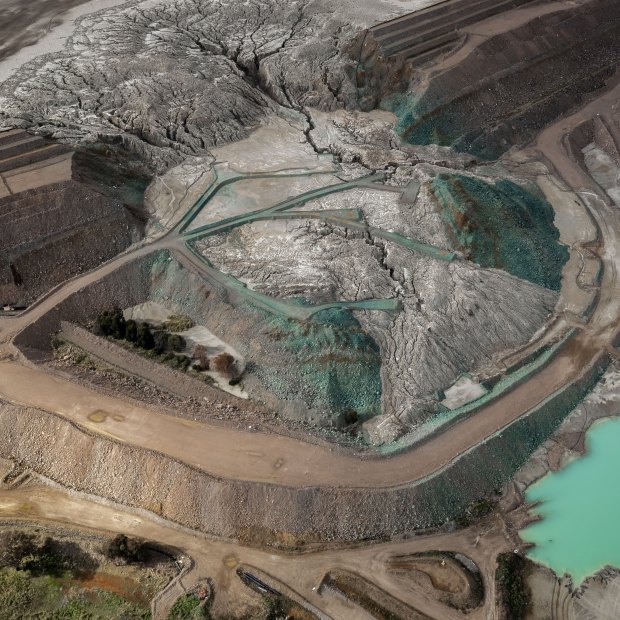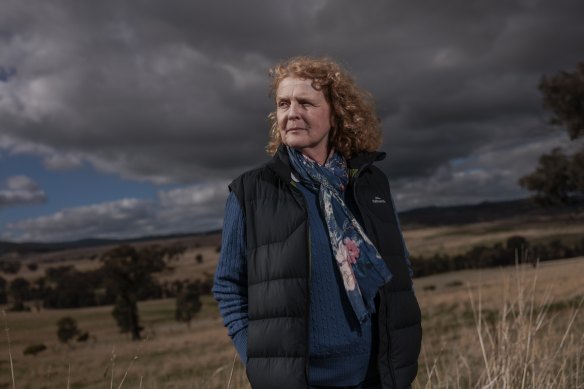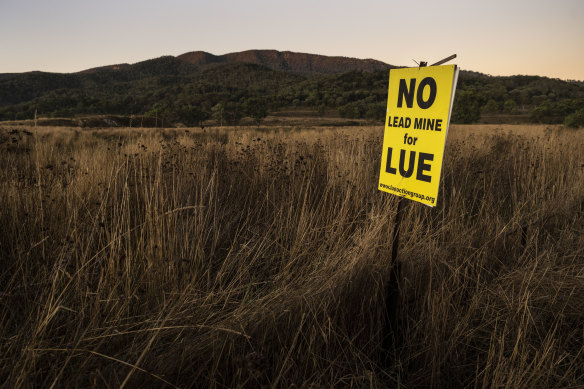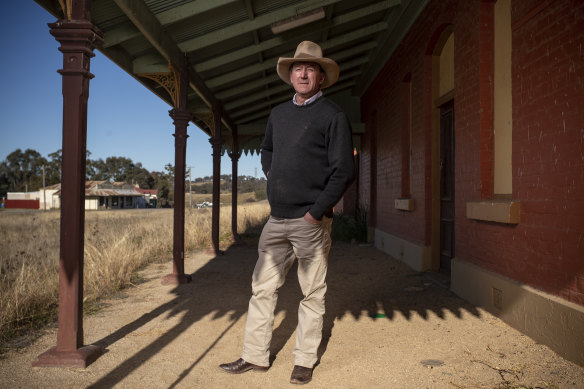
The northern tailings dam wall of the Cadia Gold Mine near Orange, NSW.Credit: Brook Mitchell
The three women sit around a wooden dining table laden with a banana cake and steaming cups of tea. The sun pours into the living room of Jann Harries’ Errowanbang home in the central west of NSW. You’d be mistaken for thinking this is a morning tea for three friends catching up, but anger not friendship brings the women together.
Harries’ home is a few minutes’ drive from Cadia, home to one of Australia’s largest gold mines, operated by Newcrest and open for a decade. The project, 23 kilometres from Orange, hasn’t been without controversy, including last month when the NSW Environment Protection Authority (EPA) threatened to suspend the mine’s operating permit after it found its main vent was emitting “an unacceptable level of dust”.
Harries lives just a few kilometres from the mine. On the morning we visit, she leaps up to check her phone every time it pings. She’s waiting for the results from a hair test to see if heavy metals are present in her body. And she’s not alone. Other residents believe they have been contaminated by heavy metals such as copper and lead from the Cadia mine.
One of the other women, Frances Retallack, pulls out a map of the region dotted with red and green pins. The pins represent the rainwater tanks around the district that she and neighbour Sally Green collected samples from over two months earlier this year. They weren’t the only community members who collected samples, which were then all sent to an independent laboratory for testing. Of the 68 samples, 15 were 10 times the safe lead level recommended by the Australian drinking water guidelines.
Some in the community believe that dust from the mine hasn’t been managed properly – allowed to drift across the region, land on people’s roofs and wash into their water tanks, drinking water and bodies. They claim there have been a range of symptoms: children have rashes, some residents say their nails have become rough, ridged and slightly deformed.
As yet, there is no proven link between the mine and these afflictions.
Concerned residents undertook blood and urine tests with local pathologists. They say their results show they have heavy metals above the recommended amounts in their bodies. For example, Retallack’s husband has three times the upper limit of nickel, while Harries’ neighbours all have selenium above the maximum range.
“I’ve been doing a table of everybody’s results and I start to see patterns. When you get the [results] individually, you don’t necessarily see that pattern,” says Retallack, vice president of the Cadia Community Sustainability Network. The group formed two years ago and has hundreds of members in the district who aim to work with the mine to find a way to live and work together.
One pattern Retallack says she’s noticed is that those who spend more time outside have higher levels of chemicals – including selenium, copper, silver, aluminium and thorium – than those inside.

“We’ve got a duty of care within our boundaries to not affect the neighbours. Why is the mine any different?” Frances Retallack says.Credit: Brook Mitchell
“We should have looked in our water tanks and done blood tests years ago,” Retallack says. The three women are angry. They say the mine had a duty of care to look after them, and it failed.
“None of us can go and spray weeds and let it drift on to the neighbours,” Green says. “If we put out fox baits, we’ve got to put a sign on the gate to alert the neighbours … We’ve got a duty of care within our boundaries to not affect the neighbours. Why is the mine any different?”
The state’s independent environmental watchdog is also paying attention. In May, the NSW EPA announced it was investigating the Newcrest Cadia mine and issued it with a pollution prevention notice and a draft licence variation “regarding the management of emissions of dust and other pollutants”. Part of that investigation will require the company to finalise and release a report examining dust and its impact on the local community.
Last month, the EPA threatened to suspend the mine’s licence when the agency found “an unacceptable level of dust” coming from the mine. At the time, Cadia general manager Mick Dewar said the company had taken immediate action to accelerate efforts to curtail known sources of dust from the underground operation.
The EPA also placed several variations on the mine’s license, including a requirement for additional vent emission monitoring and reporting.
On Friday, the EPA received the interim results from the first round of dust emissions monitoring from part of the mine, which found the operation changes made by Cadia had reduced the discharge of particles from its underground operations. The EPA has requested that Cadia undertake further testing.
But the EPA is also testing Cadia residents’ rainwater tanks, and results will be available in coming weeks. Previous tests carried out in March by NSW Health found contaminants in the local community’s tap water including copper, lead, nickel and zinc were within the Australian drinking water guidelines and safe to drink.
An honorary professor of environmental science and human health at Macquarie University, Mark Patrick Taylor, says while he understands the community’s concern, there is yet to be any cause and effect shown between possible pollution from the mine and whether it has contaminated people’s bodies.
“There is no definitive evidence ... [of] the link between the mine and what is in people’s homes – there is no definitive evidence yet,” he says. “Until we can match it up, we are swinging in the dark. But it is in the interests of the community, and it is the regulator’s duty, to establish if there is a connection between the potential source of harm and actual harm.”
Taylor believes baseline data should be collected before a mine is opened to allow for ongoing monitoring and evaluation. “That way, if something adverse happens, there is the data to fall back on,” he says.
While mining operations can affect surrounding properties, Taylor says focus should be directed at evaluating how toxic that effect is and the impact of exposure. For example, he points to a project that has mapped global soil lead contamination and shows that many places in Sydney have more than double the recommended amount of lead but it poses little-to-no risk to residents’ health. “We live in a contaminated and industrial environment,” he says.
EPA chief executive Tony Chappel says it’s vital to ensure projects are well designed and comply with the law. “The problem at Cadia is that the mine has been very dramatically exceeding the clean air regulatory standard in terms of the dust coming out of the site. No mine is allowed to operate like that,” he says. “If one operator is not meeting the standard, it obviously puts doubt in people’s minds about the broader industry.
“A well-designed and regulated mine can be a tremendous source of good in a community and globally for the planet.”
While Chappel is sympathetic to Cadia residents’ health concerns, he says the top priority is ensuring the mine complies with its legal obligations.
Most days, Retallack cries. “Sometimes your stress bucket is so full it only takes the tiniest thing to completely overwhelm you,” she says. “We are like that all the time.” The network members are determined to fight by campaigning for more regulatory investigations for as long as they can. But Harries faces a difficult decision.
The mine intends to expand its operations to border her property and her neighbours have sold to Newcrest. “We expect to work with the mines ... and we don’t want to see them close. But we deserve to be able to have clean air and not be subjected to their heavy contamination.”
Chappel says there is room for improvement in the regulatory space, including better handling of advice, from the EPA to the planning system, and how that advice takes shape in the form of project conditions.
A Newcrest spokesperson said it had heard of community members undertaking their own blood tests but had not been informed by NSW Health about these results.
“We continue to work with residents on their concerns raised in a transparent and factual manner,” the spokesperson said. “We do not compromise on people’s health and safety and remain firmly committed to meeting all our obligations in a way that is aligned with our values.”
Newcrest has also provided bottled drinking water to residents in the area who requested it.
Earlier this week, Cadia mine’s general manager Mick Dewar told the ABC that the EPA had rightly pulled it into line over its lack of compliance.
“There’s too much dust coming from the [mine],” he said. “Our most recently installed vent rise was found to be emitting dust quite a way above acceptable compliance levels.
“What we’ve been doing, and the studies we’ve been doing, is trying to look at the concerns which have been raised in the community – which are quite reasonable – as to whether there’s a health impact.
“When the EPA required us to immediately comply, we did. We’ve adjusted our operations pretty heavily to do so and we’re currently operating in compliance.”
Cadia claims spark concern elsewhere
Claims from the Cadia community have spooked residents in Lue, about 30 kilometres from Mudgee. In April, the Independent Planning Commission (IPC) approved a new silver, zinc and lead mine.
The Bowdens Silver mine owner – Silver Mines Limited – is set to produce about 3.4 million ounces of silver a year, as well as 6900 tonnes of zinc and 5100 tonnes of lead.
It is the largest undeveloped silver deposit in Australia, bringing hundreds of jobs to the region.

Lue Action Group is trying to stop the development of the open cut mine on the basis it’s too close to the town. Credit: Wolter Peeters
NSW Minerals Council chief executive Stephen Galilee said mining was a key contributor to many regional towns and one of the most highly regulated and closely monitored industries in NSW.
“Given global trends in renewable energy and other technologies, we are going to need more metals and minerals mines in NSW to meet future demand for these commodities,” he said.
Conditions of consent for the mine include a voluntary blood-testing scheme for residents to monitor lead levels and real-time air quality monitoring. Lue resident and fifth-generation farmer Tom Combes says this clause should be enough to see the project halted.
“We know we want [those minerals] ... but at the moment you can’t guarantee the community and environment won’t be affected,” he says. “So let’s leave it there until we can have that guarantee.” Combes is also the president of the Lue Action Group – which strongly opposes the mine.

“It’s all great and dandy to have jobs, but what is the point if we can’t live here,” Tom Combes says.Credit: Wolter Peeters
Combes, who lives 2.5 kilometres from the mine site, initially supported the project, citing the economic investment it would bring but, over time, he grew concerned about the environmental and health impacts the mine could have.
“It’s all great and dandy to have jobs, but what is the point if we can’t live here,” he says.
A spokesperson for Bowdens mine said the project had been approved with a range of government agencies, and that ongoing compliance would be enforced by these bodies.
“As a local Australian company, the health and safety of our local community is our top priority,” the spokesperson said. “From the outset, we have been committed to engaging the local community and stakeholders to understand concerns and issues that need to be addressed.”
For its part, a spokesperson from the Department of Planning and Environment said the IPC decision about the Bowdens mine had been rigorous and had included extensive community consultation, independent expert guidance and advice from the EPA.
The spokesperson said the approved project included strict conditions, which would limit dust and noise, as well as comprehensive environmental monitoring programs.
Despite the vocal opposition to the project, there is strong support. When the department placed the project on public exhibition, it received 1905 public submissions – 1503 for the mine and 384 against. The mine will require final approval from the Commonwealth.
But nearby resident Janet Walk says those against the project are determined to continue fighting against the mine. “The men and women in this community stared down the biggest fire this country has ever seen [in 2019-20] and they fought day and night. I can’t see them giving up [this fight]. There is too much to lose.”
Get to the heart of what’s happening with climate change and the environment. Our fortnightly Environment newsletter brings you the news, the issues and the solutions. Sign up here.